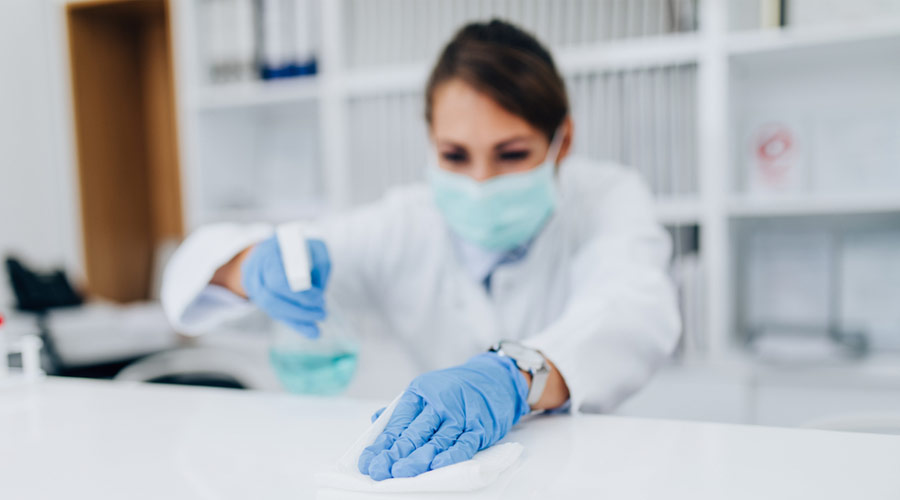Author’s note: Adapted from Provincial Infectious Diseases Advisory Committee (PIDAC) - Best Practices for Environmental Cleaning for Prevention and Control of Infections, second edition, May 2012
Routine cleaning practices are used wherever cleaning is done. Such cleaning is necessary to maintain a specific measure of cleanliness, such as hotel clean or hospital clean. Routine cleaning practices must be effective and consistent to reduce the transmission of microorganisms.
The frequency of cleaning depends on the risk classification of the surface or item to be cleaned. For example, a telephone in a patient’s room should be cleaned at least daily because many individuals might touch it, including those with infectious illnesses. A telephone in a manager’s office might only be cleaned periodically as it is used primarily by one person with no known illness.
Hotel clean
Hotel clean is a measure of cleanliness based on visual appearance. Workers don’t hide or brush aside dust and waste and say they are cleaning. They also must remove and dispose of them, including dust and soil removal, waste disposal, and cleaning of windows and touchpoints. Hotel clean involves cleaning to the point that it protects human health in general, but it still has some microbial contamination. A risk of disease still exists, but it is at an acceptable risk level.
At a minimum, cleaning must always achieve a state of sanitation. An unsanitary condition poses a likely health risk. The purpose of cleaning is to correct the risky condition. Therefore, if a risk has not been improved to a level called sanitary, cleaning has not been accomplished. Cleaning alone does not kill germs. But removing the germs decreases their number to an acceptable risk level.
Components:
- Floors and baseboards are free of stains, visible dust, splashes, and old floor finish.
- Walls, ceilings, and doors are free of visible dust, gross soil, streaks, spider webs and handprints.
- All horizontal surfaces are free of visible dust or streaks, including furniture, window ledges, overhead lights, phones, picture frames, and carpets.
- Bathroom fixtures, including toilets, sinks, tubs, and showers, are free from streaks, soil, stains, and soap scum.
- Mirrors and windows are free of dust, smudges, handprints, and streaks.
- Dispensers are free of dust, soiling and residue and replaced or replenished when empty.
- Vending machines, appliances. such as microwave ovens, refrigerators, and coffee machines, are free of dust, soiling and stains
- Waste is disposed of on a frequency that matches the traffic or usage in the area.
- Items that are broken, torn, cracked or malfunctioning are reported to the appropriate department for repair or replacement.
Hospital clean
Hospital clean is a measure of cleanliness routinely maintained in patient care areas of the hospital. Hospital clean is hotel clean with the addition of disinfection, increased frequency of cleaning, auditing, and other infection prevention and control measures in client or patient areas. Components of hospital clean include hotel clean as well as:
- High-touch surfaces in client and patient care areas are processed with a hospital-approved disinfectant.
- Non-critical patient care equipment is processed between clients and patients.
- Cleaning practices are periodically monitored and audited with feedback and education as needed.
Process or processed is defined as using a clean, high-performance, reusable, microfiber textile, such as a wiper or mop pad, and the hospital-approved disinfectant selected from the EPA List K for killing spores.
J. Darrel Hicks, BA, MESRE, CHESP, Certificate of Mastery in Infection Prevention, is the past president of the Healthcare Surfaces Institute. Hicks is nationally recognized as a subject matter expert in infection prevention and control as it relates to cleaning. He is the owner and principal of Safe, Clean and Disinfected. His enterprise specializes in B2B consulting, webinar presentations, seminars and facility consulting services related to cleaning and disinfection. He can be reached at darrel@darrelhicks.com, or learn more at www.darrelhicks.com.

 Grounding Healthcare Spaces in Hospitality Principles
Grounding Healthcare Spaces in Hospitality Principles UC Davis Health Selects Rudolph and Sletten for Central Utility Plant Expansion
UC Davis Health Selects Rudolph and Sletten for Central Utility Plant Expansion Cape Cod Healthcare Opens Upper 2 Floors of Edwin Barbey Patient Care Pavilion
Cape Cod Healthcare Opens Upper 2 Floors of Edwin Barbey Patient Care Pavilion Building Sustainable Healthcare for an Aging Population
Building Sustainable Healthcare for an Aging Population Froedtert ThedaCare Announces Opening of ThedaCare Medical Center-Oshkosh
Froedtert ThedaCare Announces Opening of ThedaCare Medical Center-Oshkosh